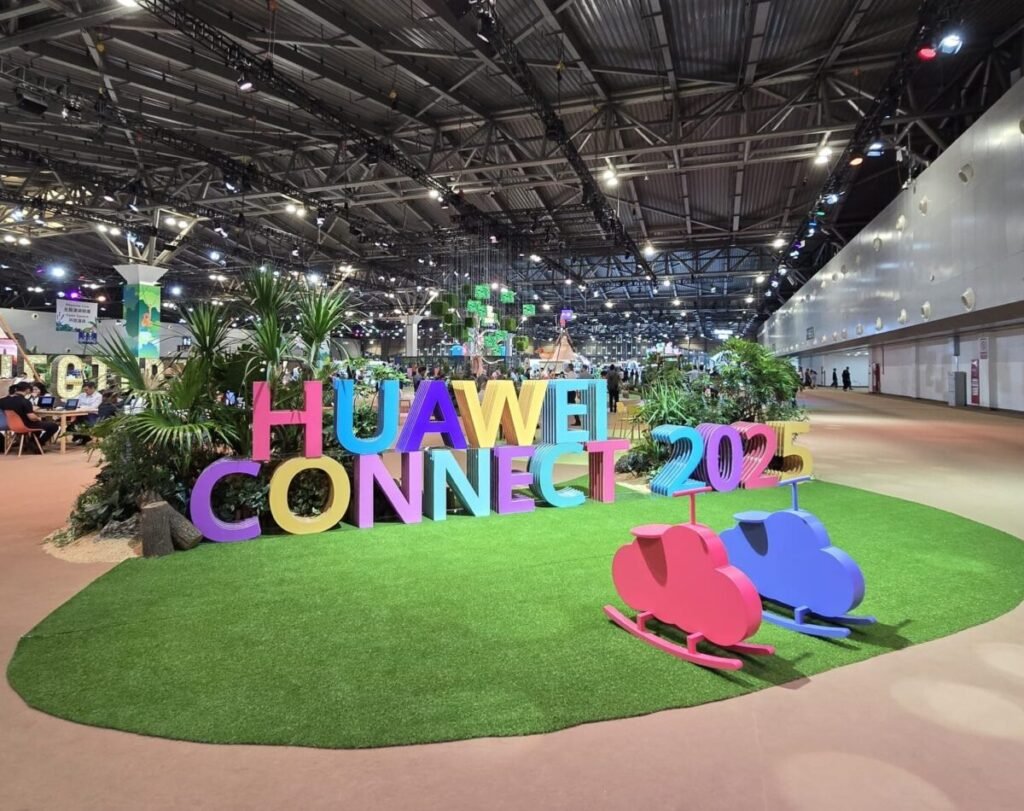Huawei Connect 2025 in Shanghai wasn’t short of big announcements, with the company unveiling new Ascend chips and Atlas SuperPoDs and SuperClusters designed to handle the heavy lifting of AI.
The Fintech Times headed to the convention – housed at the Shanghai World Expo Exhibition & Convention Centre and Shanghai Expo Centre and themed ‘All Intelligence’ – to learn more about the company’s digital finance strategy in the AI era.
But our trip to China wasn’t all conference halls. At Huawei’s flagship store in Shenzhen, we took a spin in a driverless car and tried out its latest foldable MateBook laptop, an 18-inch OLED display that folds down to 13 inches and doubles as a tablet.
In Dongguan, Huawei’s vast European-style campus had its own train and a four-storey oval library, home to over 80,000 Chinese books and 40,000 in other languages. We even spotted a David Hockney on the shelves… a reminder that Yorkshire travels far.
But back to business. In Shanghai, the focus was squarely on AI’s role in banking and how Huawei sees ‘digital employees’ taking on real jobs inside financial institutions.
When AI joins the payroll
At Connect, Huawei executives talked less about abstract AI models and more about how they’re being put to work inside financial institutions. The company’s vision is that agents trained on banking data won’t just answer simple queries, they’ll act as digital employees that can shoulder repeatable, rules-based tasks in lending, compliance or fraud monitoring.
The idea is simple enough: instead of a hundred banks each building their own proof-of-concept chatbot or loan engine, these ‘employees’ come pre-trained with industry workflows and the plumbing needed to connect with legacy systems. It could make the difference between an experiment that sits in a demo and an agent that actually shows up in daily operations.
Jason Cao, CEO of Huawei Digital Finance, explained: “Human-machine collaboration is moving from ‘people plus tools’ to ‘people plus AI colleagues’. One person can complete tasks as a team, with agents working alongside them in areas from risk management to customer engagement.”
Huawei says more than 200 financial institutions in China are already using its generative computing capabilities, with banks building out AI-driven scenarios. In insurance, one project with Pacific Insurance has created over 100 categories of ‘digital employees’ that are already in use. In health underwriting, Huawei says these agents are now working at over 98 per cent accuracy.

A cultural change
For Cao, the real measure is whether AI tools actually make people’s working lives easier. He points to sales teams who spend most of their time preparing documents rather than meeting clients. “If 70 per cent of that admin can be handled by an AI colleague, then the person can focus on the customer,” he explained.
The idea is that instead of hiring more staff for routine tasks, banks can bring in digital colleagues from a central platform to support human teams.
“We are transitioning from humans using tools. Regardless of the software we employ today, it remains a tool governed by deterministic rules. If we continue down this path, AI will become our equal,” he said.
In that scenario, the vision is “one person, one team, one agent” with digital colleagues embedded across roles from sales to risk.
It is less about counting how many staff can be replaced or how many products can be built but creating an organisational model where human and machine work side by side.
“We observe leading banks now contemplating not how many roles AI replaces or how many products it creates, but how to forge a new organisational ethos of human-machine synergy,” said Cao.

Scaling AI in finance
Risk control is another focus. Huawei described how reinforcement learning and input from experienced bank risk officers have been distilled into more than 1,000 decision ‘chains’ to guide AI colleagues through loan approvals and monitoring. Huawei says this has already lifted SME risk identification by over 50 per cent.
 In customer-facing banking, the benchmark is speed: even a one-second delay in mobile services can see almost a quarter of users drop off, so agents need to respond in under half a second if they are to work at scale.
In customer-facing banking, the benchmark is speed: even a one-second delay in mobile services can see almost a quarter of users drop off, so agents need to respond in under half a second if they are to work at scale.
To support this, Huawei is building an ecosystem of more than 150 partners contributing industry-specific tools and templates. The company’s new FinAgent Booster (FAB) is pitched as a way to bring these elements together, letting banks assemble digital colleagues quickly and adapt them across markets.
The takeaway from Connect is that digital employees are not just demo material: AI colleagues are now being built into real banking operations, handling routine tasks and delivering value. In short: they’ve clocked in.


